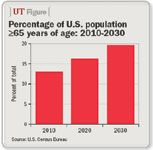Article
PSA in older men: New data, lawsuits raise the stakes
Author(s):
For clinicians, serious conundrums accompany the 80-year-old patient who arrives in the waiting room with an elevated PSA. This is the man who puts urologists and family practitioners dead center in a damned-if-you-do, damned-if-you-don't situation.
For clinicians, serious conundrums accompany the 80-year-old patient who arrives in the waiting room with an elevated PSA. This is the man who puts urologists and family practitioners dead center in a damned-if-you-do, damned-if-you-don't situation. Should they proceed with a PSA test, they may be disregarding guidelines designed in part to prevent over-testing and subsequent over-treatment in elderly men, the majority of whom are unlikely to benefit from such procedures and who are more likely at their advanced age to suffer significantly from the sequelae that attend many treatments.
Conversely, if these doctors follow the professional guidelines that recommend against testing men with less than 10 years anticipated life, they could become the target of a malpractice suit brought by patients whose prostate cancer impinges on their quality of life or by the survivors of those whose undetected cancer proves fatally aggressive. A Florida urologist found recently that the cost of following such guidelines and foregoing biopsy in an 80-year-old man is around $400,000.
Screening is pervasive

Lawsuits can attend a failure to screen patients of any age. Regardless of the size of the problem today, it will grow as the size of the baby boomer generation expands. Currently, 12.5% of the population is 65 or older. By 2030, that percentage is expected to nearly double in size, so that almost one in five Americans will be 65 years or older, according to U.S. Census Bureau data released last year. The age group 85 and older is now the fastest growing segment of the U.S. population.
Perplexing problem

Indeed, a number of high-profile studies and legal actions that transpired in 2006 appear to have muddied the already murky waters. The year closed with the December publication of a provocative article suggesting that men 65 to 80 years of age with low- and intermediate-risk prostate cancer are more likely to benefit from intervention than from watchful waiting (JAMA 2006; 296:2683-93). The study, performed at the Fox Chase Cancer Center in Philadelphia, looked at 44,630 men in the Surveillance, Epidemiology and End Results (SEER) database who had been diagnosed with prostate cancer and divided them into two groups: 32,022 men who had been treated with prostatectomy or radiation therapy within 6 months of diagnosis and 12,606 men who were placed on observation.

















